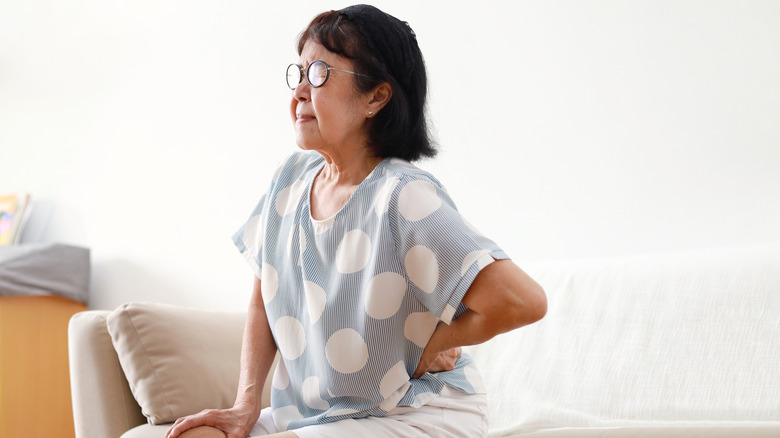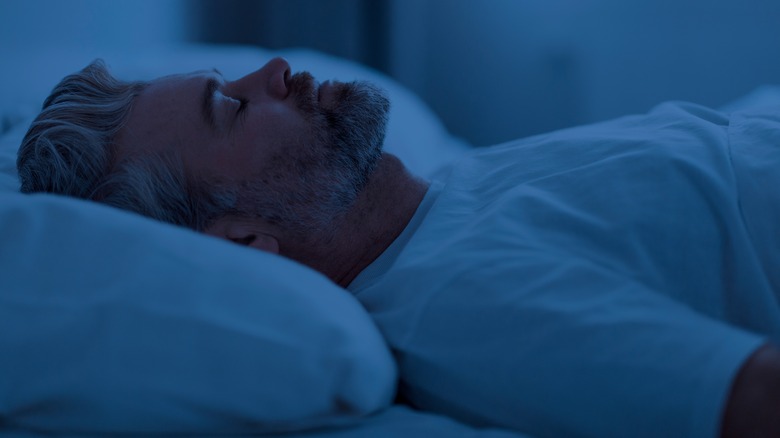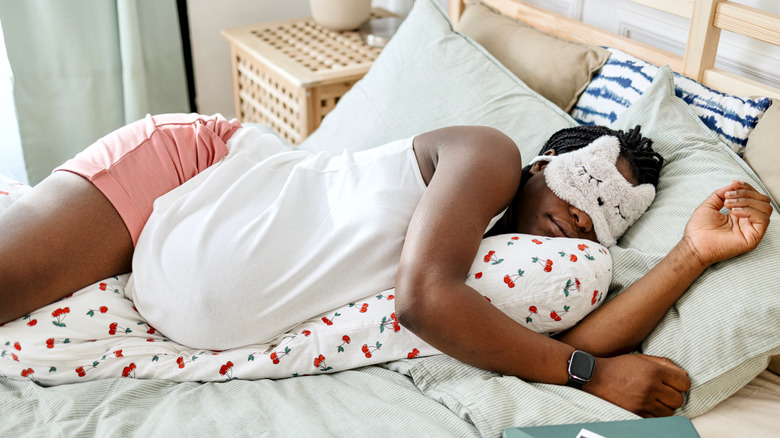This Is The Best Sleep Position For Your Hips
While sleeping is meant to be the ultimate form of rest, sometimes it's anything but comfortable. This can be particularly true for those who experience chronic pain, such as in the back or hips. Hip pain can affect people of all ages. According to a 2023 literature review published in UpToDate, between 30% and 40% of sports-playing adults deal with chronic hip pain. The same is true for roughly 12% to 15% of older adults. Depending on how you position yourself during sleep, you may unknowingly aggravate your hip pain.
There are many reasons why a person may experience hip pain come bedtime. Experts at the Arthritis Foundation explain that osteoarthritis may be one such cause. A person diagnosed with bursitis may also experience hip pain while attempting to sleep. Sometimes caused by overuse, the condition occurs when the cushiony sacs between our hip bones that are meant to reduce friction become inflamed, leading to pain and discomfort. Similarly, gluteal tendinopathy can be caused by engaging in repetitive motions, causing damage to the connecting tendons between our buttocks and hips.
Sometimes, however, a bad mattress or awkward sleeping position may be the cause of your hip pain rather than a health condition. Either way, here is the best sleeping position to try when you retreat to the bedroom tonight.
Sleep on your back and use pillows to your advantage
If you struggle with ongoing hip pain, your best bet is going to be sleeping on your back. This way, you're not placing any direct pressure on the side of your hip, such as when sleeping on your side. In addition, stuff a pillow underneath your knees. Doing so will further reduce stress in the lower back, glutes, and front of the hips, according to experts at Thompson Chiropractic & Wellness.
If you're a dedicated side sleeper, however, and only one hip is giving you grief, try to sleep on the side that isn't causing you any pain. Furthermore, to prevent your top leg from falling forward and over your bottom leg, take two pillows and secure one between your ankles and another between your knees. This will help keep your thighs in alignment and reduce strain on the body's soft tissue, thereby reducing hip pain. If you want to take things one step further, add a little extra padding underneath your hip using a soft, fluffy blanket.
Whatever you do, avoid sleeping on your stomach if at all possible. According to Tech Times, stomach-sleeping is a recipe for a poor night's sleep for those with hip pain. All that time spent on your belly overnight puts a great deal of stress on the front of the hips and lower back. This throws the proper positioning of our spine out of whack and can prompt or exacerbate hip pain.
The best sleep position for pregnancy-related hip pain
According to a 2018 study published in Therapeutic Advances in Musculoskeletal Disease, out of 184 women who had given birth, more than 32% of participants reported experiencing hip pain, predominantly during the third trimester of pregnancy. In these cases, the back-sleeping rule does not apply, as this position can instead prompt hip pain and potentially pose risks to the baby due to hindered circulation, as Thompson Chiropractic & Wellness noted. Rather, the best sleep position to reduce hip pain in pregnant individuals is left-side sleeping, which oppositely boosts circulation. Tucking a pillow between one's knees will also keep the hips supported and the pelvis properly lined up, which gives our hip joints a much-needed break.
For those experiencing hip pain unrelated to pregnancy, the Arthritis Foundation suggests a few at-home remedies to help alleviate nighttime discomfort. This includes massaging the area, taking a warm bath, or using a hot or cold compress. Getting your body moving during the day can also make sleeping easier. Stretching, walking, swimming, and reducing time spent sitting can all help reduce hip pain overnight. However, if pain or swelling fails to improve and interferes with your ability to sleep, be sure to reach out to your physician.



